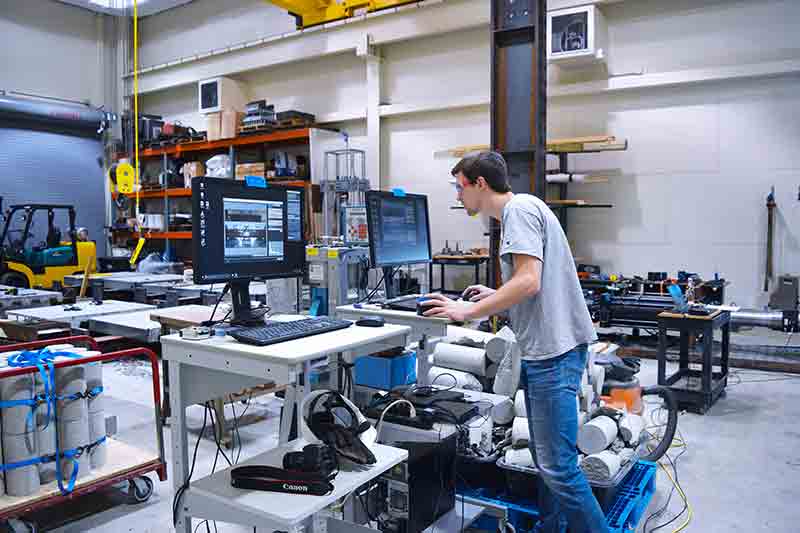
An engineer in nuclear science and technology may work from an office, at a power plant, or on a construction site. Regardless of where they work, nuclear science and technology are always moving forward. The nuclear industry is not for everyone. Working in this field is not without its positive aspects.
Job outlook
According to Bureau of Labor Statistics nuclear engineers have a good job outlook. This field is projected to grow by 4 percentage points per year through 2020, but not as quickly as other fields. There may be a decline in the number of nuclear engineering professionals in the future as the nuclear industry becomes more dependent on cheaper natural gases as a source for electricity. In addition, more medical applications of nuclear science are likely to emerge, increasing the need for qualified engineers in this field.
Nuclear engineering could be a career choice if you are passionate about science and excel at mathematics and statistics. There are many job opportunities in this area. Depending on your area of specialization, you might become a nuclear engineering supervisor or manager, or even go into sales. Remember to keep up with your continuing education, professional certifications, and other activities. Although job growth is unpredictable in this field, there are many career options available for nuclear engineers.

Education requirements
There are many options available for students who want to become nuclear engineers. Students can pursue a four year degree at an accredited university, and then work at an employer to complete a senior design project. Some schools offer dual-degree programs for nuclear engineers, which allow students to earn both their bachelor's and master's degrees in five years. A core curriculum for a nuclear engineer typically includes radiochemistry and reactor analysis. Common courses include advanced courses in nuclear enterprise management, medical physics, and other areas. Many students complete thesis projects that are research-intensive.
Nuclear engineers can move up to various positions depending on their job requirements. They may be technical specialists, managers or supervisors. To be competitive in the field, nuclear engineers must continue to learn and maintain their professional certifications. According to the Bureau of Labor Statistics' estimates, there will be a decline in the number of jobs in this area between 2020 and 2030.
Environment for work
Nuclear engineers work in a variety of environments, but the majority involve working together as part of a team. They often supervise technicians or less-educated staff. They might also have managerial responsibility. This could include overseeing aspects of larger research projects. They may also be responsible for training other employees. Safety is paramount in this field. Nuclear engineers must be cautious about how much radiation they are exposed.
Nuclear engineers work in a technical environment, but they can also be creative. Many of them work in design engineering. These engineers create new equipment and devices that produce nuclear power. Others work in nuclear research, creating new equipment or systems that help scientists better understand matter as well as energy.

Salary
A career in nuclear engineering typically begins with graduate trainee positions. You will usually work slowly and steadily. Your experience can help you move into a leadership or supervisory role, depending on how well you do. You may choose to specialize in one field. Regardless of what you choose to do, nuclear engineers should always be prepared to pursue additional training and education.
Many employers can employ nuclear engineers. Depending on where they live, they might work for a private business, a government agency, and a research organization. They may also work in manufacturing or in the nuclear power industry.
FAQ
What does an aerospace engineer do?
Aerospace engineers use their knowledge of aeronautics and propulsion to design spacecraft, satellites and rockets.
A space engineer could be involved in the design of new aircraft types, fuel sources, improving existing engines or creating space suits.
What are the jobs I can get as an engineer?
Engineers are able to find work in almost any industry, such as manufacturing, transport, energy, communications and finance.
Engineers who specialize in particular fields can often find employment at specific companies or organizations.
You might find electrical engineers working for medical device manufacturers or telecommunications companies.
Software developers could work for websites and mobile app developers.
Tech companies such as Google, Microsoft and Apple may employ computer programmers.
Is engineering difficult to study?
It depends on your definition of "hard". If you mean tough, then yes. If you mean boring, then no. Engineering isn't difficult because it involves a lot of maths, physics, and calculations.
If you're looking to learn how something works, do it! It doesn't take an engineer to become an Engineer.
Engineering can be fun as long you do something you enjoy.
Engineering isn't hard if you know the basics. However, it isn't true.
Engineers are boring because they haven’t tried other things.
They just keep doing the same old thing every day.
There are many methods to solve problems. Each method has its pros and cons. So try them all out and see which one works best for you.
What is a typical day in life of an engineer?
Engineers spend a lot of time on projects. These projects could include the development of new products or improvements to existing ones.
They could be involved in research projects that aim at improving the world around them.
They may also be involved in the creation of new technologies, such as computers, phones, and cars, planes or rockets.
Engineers need to have imagination and creativity to succeed in these tasks. They should be able and willing to think outside the boxes to come up with creative solutions.
They will be required to sit down with their ideas and develop them. They will also be required to test their prototypes and ideas with tools such as laser cutters and CNC machines, 3D printers and laser cutters, computer-aided designs software and other equipment.
Engineers need to communicate well to convey their ideas to others. They need to write reports and presentations so that they can share their findings and ideas with clients and colleagues.
They must also manage their time effectively in order to complete the tasks within the time allowed.
No matter what kind of engineering you choose you must be creative, imaginative and organized.
Statistics
- 2021 median salary:$95,300 Typical required education: Bachelor's degree in mechanical engineering Job growth outlook through 2030: 7% Mechanical engineers design, build and develop mechanical and thermal sensing devices, such as engines, tools, and machines. (snhu.edu)
- 14% of Industrial engineers design systems that combine workers, machines, and more to create a product or service to eliminate wastefulness in production processes, according to BLS efficiently. (snhu.edu)
External Links
How To
How to read engineering drawing
Engineering drawings are a visual representation of an object. They contain many elements such as dimensions, symbols, text, etc. Since ancient times, engineering drawings have existed. The 3000 BC mark was when the first known drawing was made by an Egyptian engineer. Engineers use them for designing objects such as bridges, machines, and buildings.
Engineers use engineering diagrams to show what something looks like. This helps others to understand what you are talking about. Engineers make things by using symbols and numbers to measure. This makes it easy for people who don’t know much about engineering.
There are two main types, 2D (or 3D) of engineering drawings.
2D drawings are flat representations for three-dimensional objects. These can include sections, elevation views, plans, and axonometric projects.
3D drawings can be used to show real-life objects at multiple angles. Computer software is often used to create 3D drawings. SketchUp allows you to display a model from the top of a bridge. Next, choose "View" and "Top View." Next, rotate your view so that you can see everything from the top.
2D drawings should be viewed in the entirety. You shouldn't be focusing on just one area. Be sure to look at the entire area, even if it is just in one corner.